November 3, 1923 Kentucky, Homecoming, and Dedicating The New Stadium

Kentucky had grown tired of losing to Centre and had developed a system where alumni in each of the 120 counties of the state were asked to watch out for good high school athletes in their area and try to steer them to the university.
Ben Cregor received permission to develop a program for Centre which was hoped would counter the efforts over in Lexington. He would visit various high schools which played football and invite the entire team and coaching staff to come to Danville to watch a game. Of course, there would be no charge for admission, and after the contest, the high school players would get a chance to meet and mingle with the Colonels.
For the Homecoming game, Cregor traveled to Richmond, Kentucky and invited the team of the just completed Richmond Madison High to come over to Danville, and even though tickets were being scalped, Cregor said he would find room to squeeze the visitors into the new stadium for the Kentucky game, or let them stand behind the Colonels' bench.
It was a great recruiting tool. There was no more exciting contest or atmosphere for an impressionable boy in Kentucky than to witness a Homecoming game between Centre College and the University of Kentucky, especially in what was certain to be a stadium packed with an enthusiastic, screaming crowd.
There are traditional football rivalries which are huge. Many were established in the early decades of college football and over the years gained national recognition.
Army-Navy Texas-Oklahoma Michigan-Ohio State Florida-Georgia Auburn-Alabama Southern Cal-Notre Dame California-Stanford Harvard-Yale
Centre and Kentucky? Hardly. At least, not now.
But in the years after the Great War, at least in the Bluegrass, it was- Centre and Kentucky.
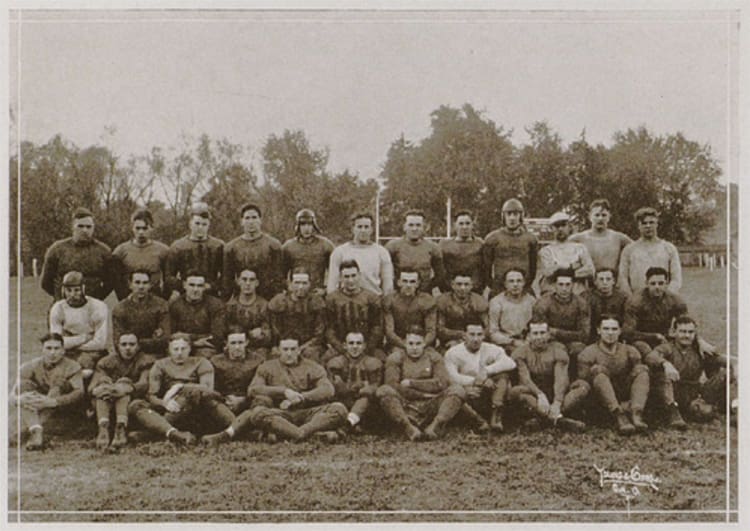
1923 Kentucky Wildcats
After the 1922 season. Kentucky Coach William Juneau resigned after heading the program for 3 years, 1920-22. He compiled a record of 13-10-2 in Lexington. Since Kentucky had the goal of being the premiere football program in Kentucky, his 3 straight losses to Centre by a total score of 131-3 may have been a factor since Juneau never coached another college football game after leaving Kentucky.
Juneau entered the real estate business after his retirement. Perhaps after having given up so much real estate to the Colonels over the last 3 games, he decided it might as well profit from selling it. He died in Milwaukee in 1949 at the age of 70.
As Juneau's replacement, Kentucky chose a new coach who had played at Princeton in 1917, Jack Winn, who had been the Wildcats' line coach in 1922. Winn lasted one year at Kentucky, compiling a record of 4-3-2. His only other coaching experience was spending one year at Transylvania in 1932 when Transy and Kentucky didn't compete.
( Kentucky played all of it games against Southern Conference opponents in 1932. Transylvania wasn't a member. )
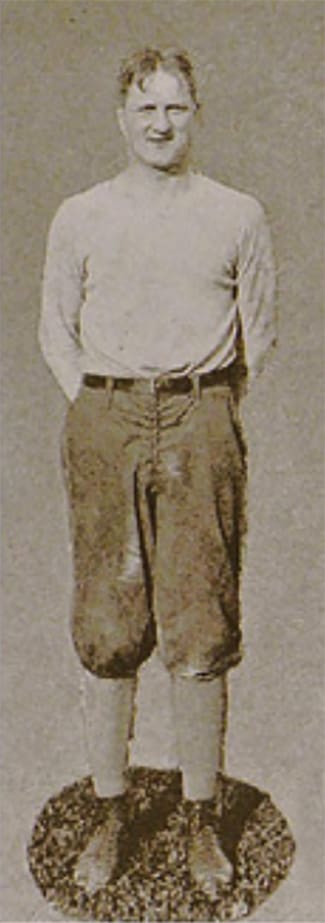
New Kentucky Head Coach, Jack Winn
After the 1916 blow out with Kentucky winning 68-0, the series stood 13-9-1 in Centre's favor. Going into the 1923 contest, with Centre having won the last 5 games by a cumulative score of 190-3, the Colonels held the edge, 18-9-1.
Kentucky had become absolutely obsessed with beating Centre. Likewise, Centre's goal was to continue beating Kentucky. The press played up the rivalry and made the public feel that either team's season was successful, irrespective of other games, if their main, in-state foe was vanquished.
That passion was why so many of the Centre partisans quickly forgot about the defeat at the hands of Pennsylvania. After all, that game was in a faraway place against an unknown team. But now, it was- Kentucky.
Kentucky was playing pretty good football coming into the Centre game. The Wildcats were 4-0-1.
Kentucky 41 Marshall 0
Kentucky 14 Cincinnati 0
Kentucky 6 Washington and Lee 6
Kentucky 28 Maryville 0
Kentucky 35 Georgetown ( Ky.) 0
The competition hadn't been especially dazzling, but tying Washington and Lee was significant as W&L ended up tying Vanderbilt for the Southern Conference title in 1923, with the Generals' 6-6 tie with Kentucky being the only blemish in their conference games.
The November 3 game was important to Centre for several reasons.
Obviously, the most important was the rivalry between the two schools, and the fact that the winner would be thought of as the best team in Kentucky. Also, Uncle Charlie was anxious to put the Penn game behind the team and get back into the win column. Additionally, the game could possibly be an important part of the claim to at least the "mythical" Southern Championship. And finally, it was the game in which the new stadium would be dedicated.
Lexington had developed "Centre Fever," as one sports writer deemed it. And again, "This is the year!" was the motto.
The Southern Railroad had plans to assemble special trains to bring 3,000 fans to Danville on Saturday, arriving at 1:30 P.M., an hour before the kickoff. In addition, the railroad had lined up multiple Pullmans to bring passengers over from Lexington and Louisville late Friday afternoon for those who wished to take in the Friday evening Homecoming activities. The Pullmans would be left on a siding for the passengers to use as a "hotel" during their stay, departing from Danville early Sunday morning so that the passengers could attend the dance in the Boyle-Humphrey Gymnasium on Saturday evening after the game.
The game had generated to much interest in Lexington that a Grid-Graph had been set up in the Phoenix Hotel for fans who couldn't get over to Danville for the game.
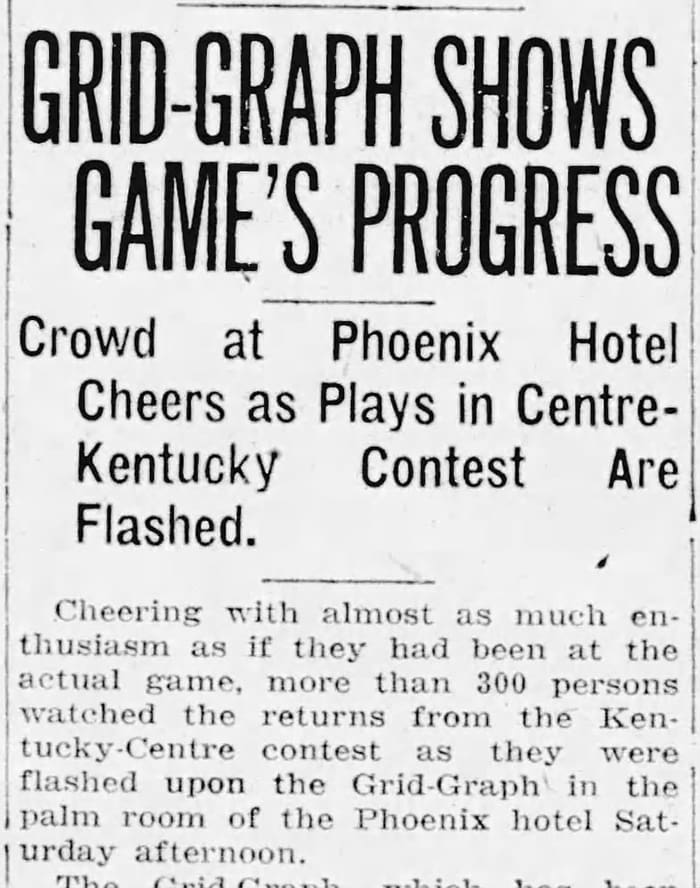
The Phoenix Hotel "carried" the game via a Grid-Graph in the hotel's Palm Room
Again, as in previous years, all of the rooms at the Gilcher and Henson hotels on Main Street had long been booked. Boarding houses were full, and the citizens of Danville who wanted to accommodate overnight guests contacted the local Chamber of Commerce and let their willingness be known. Special buses were arranged to carry people from the Beaumont Inn and guest houses in nearby Harrodsburg to Danville and back.
Danville literally mobilized for Homecoming!
Every restaurant laid in extra supplies. Florists made certain that they had adequate amounts of flowers in the two team's colors. Again, Spoonamore's and other drug stores did a landslide business in selling crepe paper and pennants until Danville was covered with Centre's gold and white. The local medical community set up a first aid station in the science building, Young Hall, to be staffed all day the Saturday of the game.
Downtown merchants received an appeal from the Chamber to be certain and sweep the sidewalk and gutters "in order that the many visitors will see a pretty and clean town."
Workers had taken timbers from the old stadium and constructed 5,000 temporary seats in the end zones, and by the time those were counted, it was estimated that the total attendance would be 15,000.

Such was the interest in the state rivalry
There were so many tasks to take care of. How many members of the press will be at the game and are there adequate chairs in the press box? Do we have enough students to sell programs? What about parking and who will be in charge? Who will make certain that the governor's parking spot isn't taken? Will the bath rooms in the Carnegie Library be adequate? Are they stocked?
The "Courier-Journal" planned on having photographs available for its "bulldog" edition which hit the streets in Louisville at 9:00 P.M. Saturday night. The paper stated that it would not only have "action photos, but images of the crowd in the new stadium."
It was announced that classes at Centre and K.C.W. were cancelled on the day of the game. All of the merchants had signs printed which they could quickly put on their door or window which announced that they were "Closed for Game."
Papers were published all over Kentucky with previews of the upcoming "Harvard-Yale Game of Kentucky."
Each night of the week leading up to the game, pep rallies were held on the Centre campus, including a performance by the Centre "Six" on the steps of Old Centre. There was a final huge rally on Friday evening attended by all of the students from Centre and K.C.W., along with townspeople and out-of-town guests, just before the smoker and dance in the gym.
Meanwhile, while the town and college were getting ready, Uncle Charlie was similarly getting his team primed for the game.
In analyzing the Penn game, it was felt that the line needed extra help, and Red Weaver was contacted and agreed to come to Danville for the week to assist Ben Cregor. Uncle Charlie told friends confidentially that his goal was not only to shut out Kentucky, but to hold the Wildcats' offense to under 100 yards.
"We can score against Kentucky, I'm confident of that. We're working this week on defense."
During Thursday's practice, an airplane flew over Cheek Field, banked and came down low and circled the field several times. Uncle Charlie blew his whistle and halted practice until the plane finally gained some altitude and flew toward the direction of Lexington.
"Can you believe that?" Uncle Charlie declared. "They're trying to spy on our practice. Those varmints!"
It was never proven that it was a reconnaissance flight, but Centre always believed that someone had tried to take photographs of the Colonels' formations. At least that was the story, bolstered by the fact that one could go days without seeing a plane circling in the skies above Danville, Kentucky.
Former Colonels' players arrived in Danville on Friday. Bill Shadoan came down from Valparaiso. Terry Snowday was in Ashland and came over through Lexington. ( Terry's brother, Roger, was a junior and on the football team. He was also quite a baseball and basketball player, being the captain of the basketball team in 1924.)
Chick Murphy came from Columbus, Ohio. Phil Pigeon, a star halfback some years before, checked into the Gilcher. Tom Moran came up from Jefferson City, Tennessee to see his old teammates, and to lend support to his father.
Herb Covington's parents and Hennie Lemon's mother came from Mayfield. Bo sent a telegram expressing his regret at not being able to attend, but urged the team on.
It was reported that Coach Jack Winn of Kentucky had driven his team hard all week with the slogan, "Beat Centre's line and you beat Centre!"
Jop, on hearing that, wrote in his "Sport Flashes" column:
We believe that Kentucky has as much of a chance of tearing our line to ribbons as an armless man would have in winning a bowling tournament. Any time you see a Centre gridder giving up to a blue-sweatered U.K. individual, you can believe it's snowing in South Florida.
Centre and Kentucky felt that the game was important enough to warrant 4 instead of the usual 3 officials. F.A. Lambert from Ohio State, Don Henry from Missouri, Roger Johnson from Michigan, and Kenyon's Harry Wessling were brought to Danville to call the game.
I think when looking back on my football experiences at Centre that other than going to the 1922 Harvard game, the most exciting and colorful, perfect example of what college football was meant to be, was the week of Homecoming in 1923, my junior year. There was such spirit. We had lost to Pennsylvania, but everybody knew we had a great team, and we all wanted to show our support even more because of that loss. It's easy to back a team when they win. And we nearly always won. But it's even more important to get behind a team that has just lost, and pull them back up by the spirit and support that you show when the guys are maybe a little down.
We had such great pep rallies that even if members of the team were in a skull session, or in their room resting, they could hear the shouting which literally filled the campus. We had a big rally out on the baseball field which I can still visualize, and even smell the smoke which came off a bonfire which we built.
Howard and his group, the "Six," were there performing, and we all clapped and kept rhythm as they played, and then they began these little bursts of music like they had at Harvard. They'd play a few bars and stop suddenly and we'd shout "Fight!" Over and over. They'd play and we'd shout, "Fight!" It made chills go down your spine to be out in the cool nighttime air, huddled around a big fire, and just spontaneously be involved in such a wonderful show of love for your school, and love for your team. Everybody was there.
Duh de dum, duh de dum- "Fight!"
Duh de dum, duh de dum- "Fight!"
Over and over.
Duh de dum, duh de dum- "Fight!"
I'm not certain that students do that sort of thing anymore. If they don't, they're missing something. They're missing something they would remember all of their lives.
It was an overcast day. The prediction was for rain, but it was still dry, though threatening, as the crowd converged on the stadium. Despite all of the planning, no one had seen the consequences of 3,000 people disembarking from the trains and arriving virtually as one mass. Nor did the Centre authorities realize that many people wouldn't want to immediately go to their seats, but rather just stand at the north end of the field, the end nearest the gates, in order to stare and admire the magnificent new stadium.
The bottleneck and confusion caused the dedication ceremony to be missed by most of the fans due to the noise, the onset of thunder, and then the final rush to get to their seats. Contemporary accounts stated that Dr. Montgomery gave a nice speech, and the ribbon, which is always part of such proceedings, was duly cut, having been held by two Centre cheerleaders, but the impression was given that the whole affair was under appreciated because just as Dr. Montgomery was unwinding, the sky was unleashing, and a real downpour soaked him and every one of the 15,000 people who were squeezing into and around the new stadium.
Despite the less than auspicious start, the crowd remained jovial and excited, anxious to get the game underway, and to cheer on their favorites. Game time was 2:30.
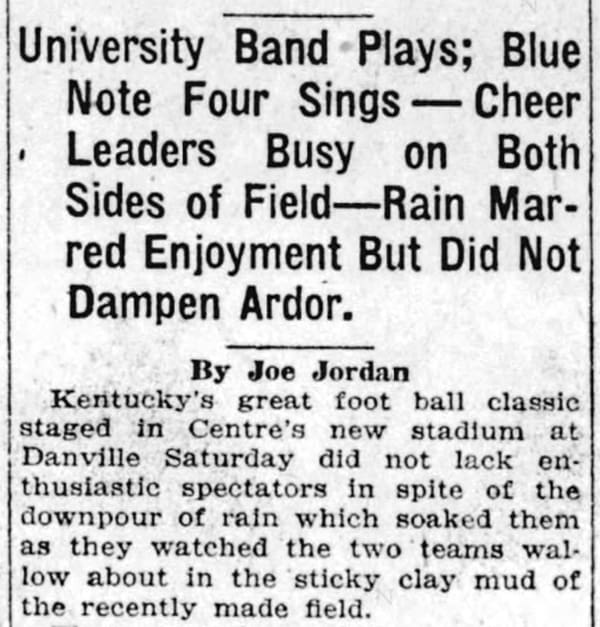
Kentucky brought its 62-member band to Centre's stadium dedication


The "Leader's" coverage included the band's playing "On, On, U of K"
( For a complete explanation of the derivation and timeline of Kentucky's wonderful "On! On! U of K," please see Chapter 100. The lyrics are in Chapter 125. )
"This is the year!"
After the brief but intense shower, Uncle Charlie decided to make some last minute changes in his line-up. The turf at Cheek Field looked great, but it was deceptive, as the roots of the grass weren't deep, and in the warm-ups, footing seemed slippery and uncertain, and every time someone slid, the grass went shooting off, producing divots.
Uncle Charlie decided to start his heaviest backfield, and that meant switching 185 lb. Minos Gordy to fullback, moving Case Thomasson out of the backfield to Gordy's end position, and replacing the 152 lb. Hope Hudgins with sophomore Murrell "Jake" Summers, at 177 lbs. The plan was to concentrate the Colonels' attack on running, just pounding the Kentucky line.
KENTUCKY CENTRE
RICE, A.T. 185 LEFT END LEMON 170
MONTGOMERY 221 LEFT TACKLE SKIDMORE 175
RAMSEY 178 LEFT GUARD RUBARTH 170
SAUER 187 CENTER KUBALE 185
RICE, W.H. 180 RIGHT GUARD LYNCH 195
STEVENSON 209 RIGHT TACKLE CHINN 220
KING 178 RIGHT END THOMASSON 175
HUGHES 155 QUARTERBACK COVINGTON 160
KIRWAN 184 LEFT HALF SPURLOCK 185
TRACY 155 RIGHT HALF SUMMERS 177
SANDERS 180 FULLBACK GORDY 185
Ed Kubale won the toss and Centre received. Herb Covington returned the kick 37 yards and would have scored except for a last ditch tackle by a diving Wildcat. The Colonels then followed their game plan, running 14 straight ground plays. Hennie Lemon capped the time-consuming drive by kicking a field goal from the 20, and Centre led, 3-0.
Many of the capacity crowd were still admiring the stadium or trying to get seated when the successful kick was made.
Centre moved the ball at will the rest of the half, and played gang-tackling, inspired defense, spurred on by Uncle Charlie letting the team know in his pre-game speech that his goal was to hold the Kentucky team to less than 100 yards of offense.
Once the Colonels got to the Wildcats' 6 inch line, but couldn't buck it over. Several times drives stalled within the Cats' 20. Twice, after Lemon's first kick, he again attempted field goals, but the field conditions made it hard to make perfect contact, and both efforts were wide.
Centre picked up 11 first downs to Kentucky's two, and one of those was due to a penalty. Despite the overwhelming superiority of the Gold and White, the 1st half ended with the Colonels up by only 3-0.
Halftime saw the Kentucky band try to go through a spirited, precision drill while playing their selections on the field's slick grass.
You know how certain things stand out, so that you later remember them, especially if they're humorous? Kentucky's band had a sort of heavy tuba player- I think that was the instrument. Anyway, it was one of those big horns. He was trying to follow along during the marching, and apparently he was supposed to spin around on his heels and take off in another direction.
As he turned, his feet went out from under him and he fell flat on his back, and his instrument went flying off to the side, and another band member was blowing away, not paying attention, and he tripped over the big horn and landed flat also, but he fell forward, and it looked like he'd nearly impaled himself on his own horn, but he eventually got up and shook the mud and grass out of his instrument and tried to keep playing. Several of the members of the band had to quit playing because they were laughing so hard, including both of the guys who had fallen.
It was about that time that they decided to stop trying to march, and just stood around out on the field and finished their songs. The crowd loved it so much that they got a long, standing ovation when they finally walked back off the field.
Several of us decided later that they should have put that routine into every halftime performance. It was like one of those Keystone Cops, slapstick movies which were so popular back then.

Added attraction during the UK Band's halftime performance
The band's performance was the highlight of Kentucky's efforts that day.
Henry Bloom, sports editor of the Louisville "Post," was in the new press box for the game, and wired a story back to his paper.
If Centre can continue to play the kind of football she displayed today against Kentucky, she will probably win the remaining games and capture the Southern crown. The Penn game made Centre. The defeat proved a bitter but beneficial tonic.
Saturday, Centre put the best football team she has ever had on the field. This may sound extravagant to those who recall the days of Red Weaver, Bo McMillin, and Red Roberts. While it is true the Colonels have no individual stars to measure up to those players, they have the best teamwork that any Centre eleven has ever shown. The line charged compactly, the tackling had ferocity, the interference and blocking were superb, and the generalship by Herb Covington was flawless. Eleven players took part in every play.
Centre was a machine. The plays were run without a hitch, and the thorough drilling the team got was evident in the smoothness of every move.
For Kentucky, it can only be said that the players were courageous and fought with all of the individual skill that they possessed.
After Covington' s return of the opening kickoff brought the ball into Kentucky's territory, Centre played the entire first half in Wildcat territory, and Kentucky never crossed midfield.
The 3rd quarter was more of the same. For Kentucky, it was 2 or 3 offensive plays and then a punt. For Centre, it was a steady advance all during the period, but each drive was ultimately frustrated by a desperate Kentucky defense.
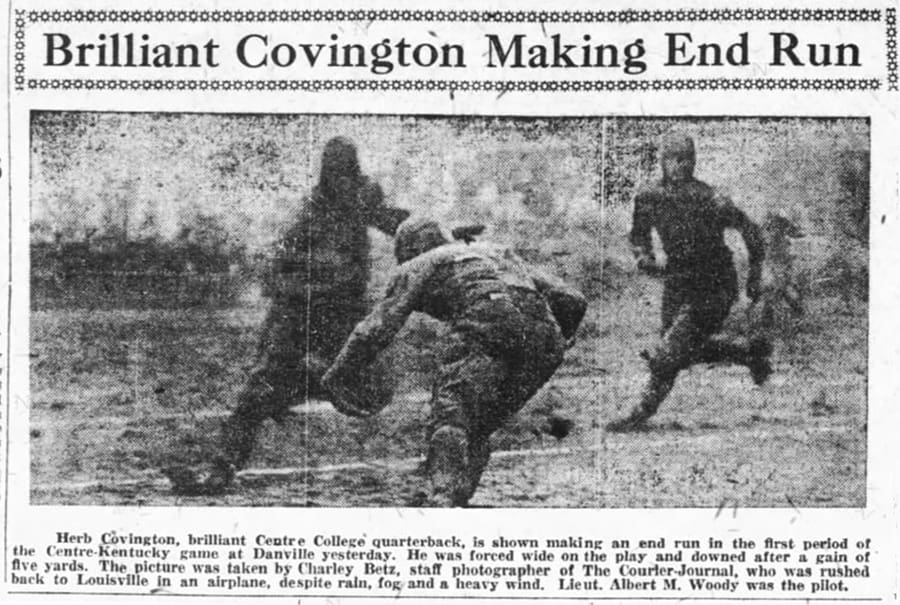
Jop had some choice comments in his coverage.
Coach Winn tried to dam the leaks in his defense and moved up replacements like a field general trying to brace a faltering division.
Centre's defense was as tight as a window in a Pullman car.
It was one of the cleanest and dirtiest games ever played in Kentucky. The cleanest because of the wonderful sportsmanship displayed by both teams. The dirtiest because of the condition of the field. Enough towels were used in wiping off the ball and player's faces to stock a city hotel.
In the 4th quarter, Covey sent Albert Spurlock and Case Thomasson downfield, one right behind the other. Kentucky had only one defender, Al "Ab" Kirwan, defending the area. Case hollered to Spurlock, "You take the pass and I'll block the back."
Thomasson brought Kirwan to the ground by a roll-block, and Covey, because the ball was so slick, took both hands and shot it like a basketball toward Spurlock. The ball arched up in the air and floated without a spiral to "Spur's" outstretched hands, and the halfback pivoted carefully, and gingerly ran untouched across the goal.
Jop: With the score, Centre had a comfortable lead, and Kentucky's hopes perished like a bamboo hut in a fire-swept village.
Spurlock, known as "Cyclone" to some, got a reserved seat in the Centre "Hall of Fame" by his performance today.
Hope Hudgins, when he replaced Summers, played beautifully, picking up yardage on every play. Ed Kubale, "the battling fool," played wonderful defense and his center passing of the slick ball was unerring.
Covington was master of the situation at all times. He handled the slippery ball like a salty fisherman lassoing his catch.
Danville is making merry, for the Colonels have come back.

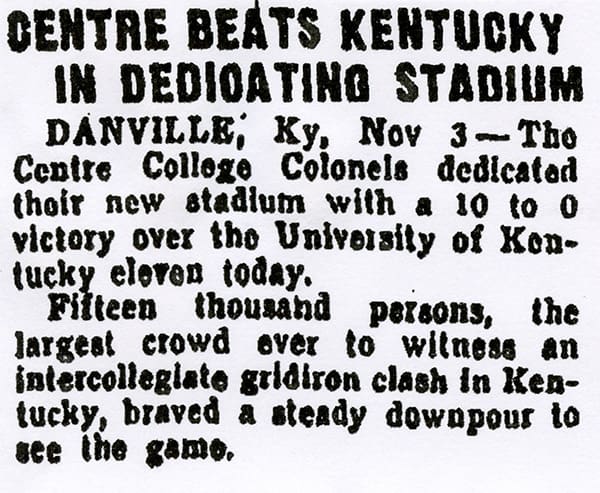
15,000 in attendance, more than the entire population of Boyle County
When one looks at the final score of 10-0, it seemed like the two programs were reaching parity. It may have been thought that Kentucky was narrowing the gap. It was 56-0 in 1919, 49-0 in 1920, 55-0 in 1921, and the 1922 game ended, 27-3.
However, the statistics and analysis of what happened on the field didn't exactly bear that out. Centre had 17 first downs to Kentucky's 3, and one was due to a penalty. In 60 minutes of play, the Wildcats never crossed midfield, not once!
That was domination, whatever the final score.
Toward the very end of the game, when victory seemed certain, Uncle Charlie made only his second substitution of the game. Jimmy Green, the senior from Louisville, was playing in his last game in Danville, as the rest of the schedule would be on the road.
Uncle Charlie called Jimmy over and had him remove his helmet and signaled for Captain Kubale to call time out. Then the Centre mentor walked Jimmy half way out to Centre's position on the field and took off his hat and turned to the home, west side fans, and waved his hat back and forth, as the players on the field and on the bench began to whistle and shout, and then the fans all got on their feet and joined in the cheering. Hope Hudgins came out of the game after hugging Jimmy on the field and Jimmy stayed in the game for a few plays.
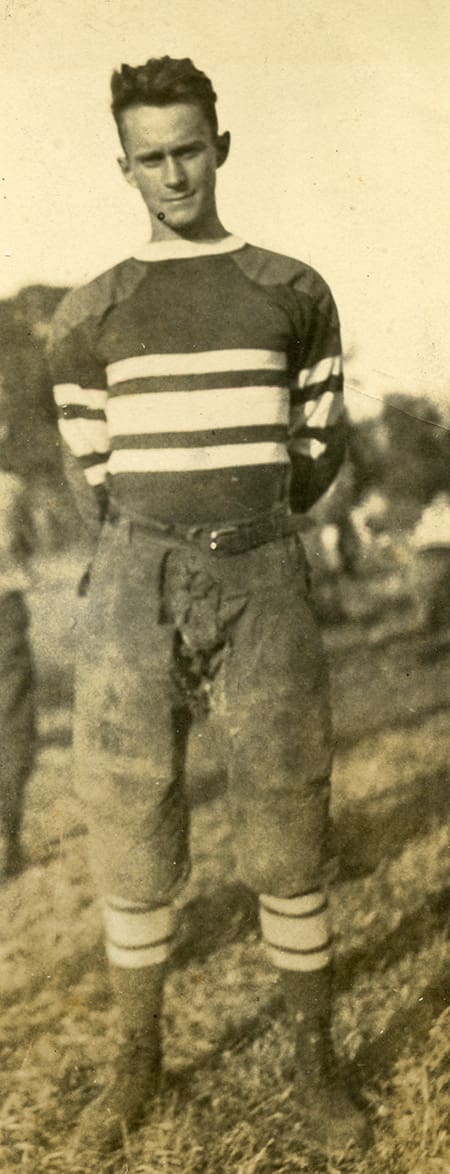
Louisville's Jimmy Green
It was a wonderful demonstration for Jimmy Green. I was a scrub on the baseball team and Jimmy was quite a player. Played second base. He didn't have a great career in football, because he had so many fellows who were better than he was playing in the backfield. But he was out there every year, and he was captain of the basketball team one year, and played tennis on our little tennis team, and in addition to that, he was just a prince of a fellow. Everyone stood and cheered when he got in for a few plays, and then Uncle Charlie took him out and let him run back off the field and he got a huge ovation again. It was a great way to end his career on Cheek Field.
Before the game had ended, a photographer named Charles Betz from Louisville's "Courier-Journal," raced from Cheek Field packing a bag with his camera and rolls of film, jumped in a car and sped away. His destination was a field just outside of Danville which served as the area's airport. He had been assigned to cover the game and dedication of Centre's new stadium. The "Courier" wanted to publish the first photographs of the event which would be exclusive to its readers.
Waiting in the field, with the plane's prop already spinning, was Lieutenant Albert Woody who had flown over from Louisville out of the Bowman Field Airport off Taylorsville Road in a plane owned by A. H. Bowman and Bowman's partner, Bob Gast.
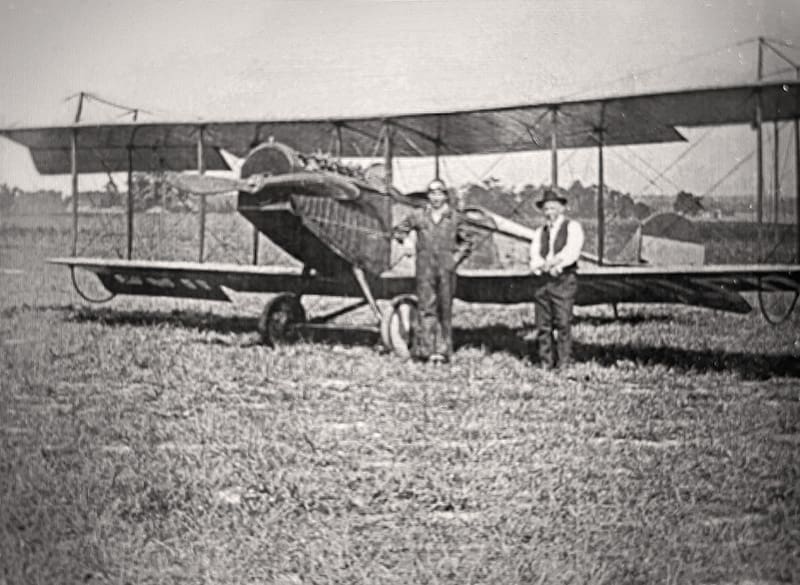
Curtis Canadian Jenny plane with A.H. Bowman, left, with his partner, Bob Gast
Betz had gotten all of the pictures he felt he needed before the game ended, with some shots of the action on the field and the crowd in the new stadium. He left early because he had a deadline to meet.
It was just after 4:00 PM and raining when Betz arrived at the airport which had made flying somewhat questionable. Nonetheless, he jumped in the front seat with his bag and Woody revved up the engine and accelerated across the field until the two climbed into the air.
The lieutenant planned to fly by compass until he reached the area outside of Louisville where he thought he could pick up some landmarks which would allow him to find his destination, back to Bowman Field.
Unfortunately, as the two headed northwest toward Louisville, the weather had deteriorated, producing thick clouds and increased wind-swept rain which made it virtually impossible to spot any familiar sights as they began to circle what they felt was the city. After circling several times, Lieutenant Woody finally was able to spot the Ohio River but couldn't determine if he was up or downstream from Louisville. He decided to take a chance and descend lower out of the clouds to better try to figure out his location.
It was an extremely perilous situation as both of the men tried desperately to pick out any road or building which they could identity. More than once they felt they were close to crashing and Lieutenant Woody decided, as they hugged the south edge of the river, that it would be safer to just try to come down on land rather than ditching in the water if they had to make a choice.

A truly perilous journey
However, suddenly there was a momentary break in the clouds and they both shouted out that they could see the Louisville Gas and Electric buildings and smokestacks just to their right, near the river, at its 3rd Street facility.
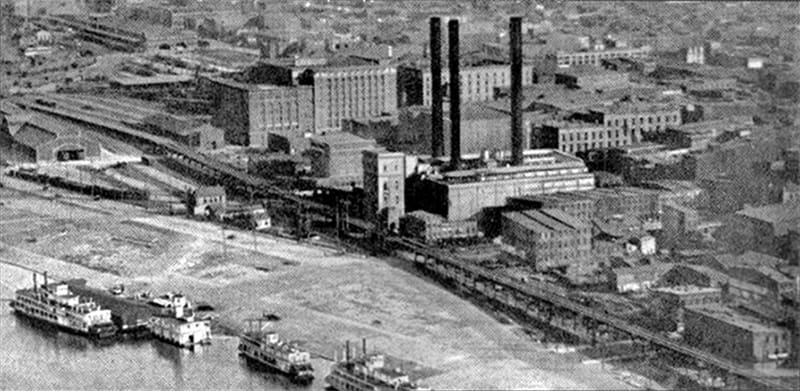
Smokestacks visible at LG&E not far from the Ohio River which served as a landmark
Lieutenant Woody veered to the right, just over land, continuing east until they spotted the classic buildings of the Louisville Water Company with its ornamental water tower to their left near River Road, which indicated they were just a couple of minutes northwest of the airfield.

The Louisville Water Company on the Ohio River with the oldest ornamental water tower in the world, built in 1860
Woody banked away from the river and headed toward what he knew was the direction of Bowman Field.
A. H. Bowman had turned on all of the lights of the cars around the field and those on the hanger. Through the rain, the lights were spotted and Betz hollered back to Woody that he could see them.
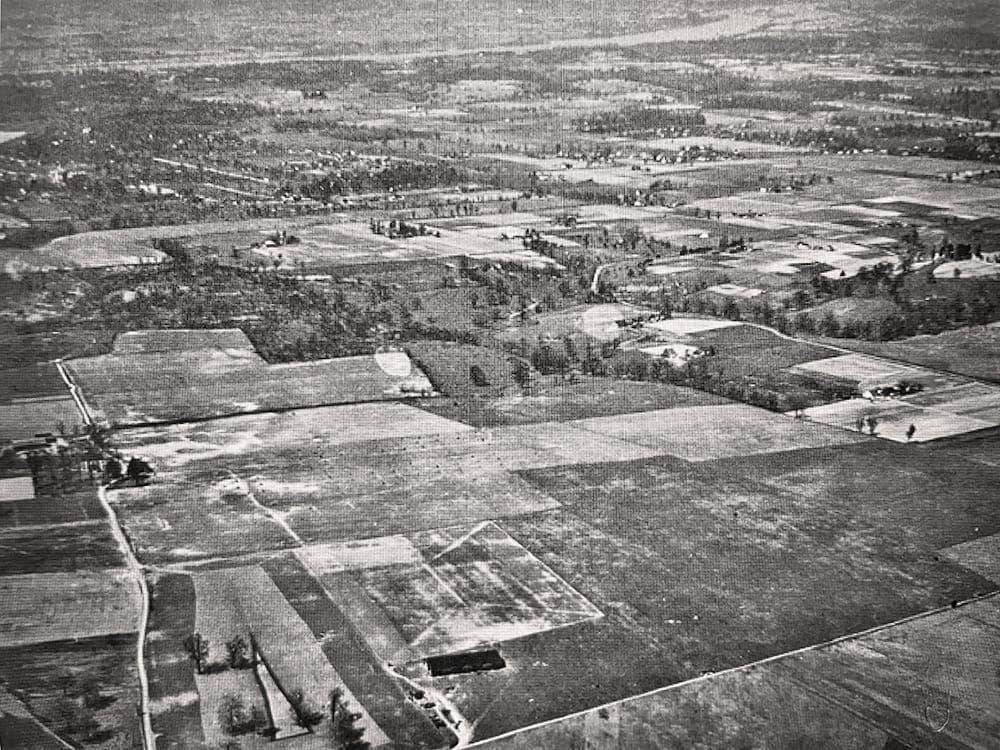
Bowman Field was literally a field. The lone hanger is shown with the black roof, lower center. The Ohio River can be seen in the far distance.
The plane was eased down onto the grass, bumping a couple of times before braking to a stop.
A car raced over and met the plane as Betz jumped down on the wing and hopped to the ground carrying his bag.
The driver shouted, "Come on, hurry, we're waiting for your film," and Betz shouted thanks to Woody and he and his co-worker headed at full speed toward the downtown office of the newspaper.
The photographs appeared in the Saturday evening, 9:00 PM "bulldog" printing of the first edition of the November 4, Sunday morning "Courier-Journal," and in the later editions which appeared all over the Louisville area and throughout the state.
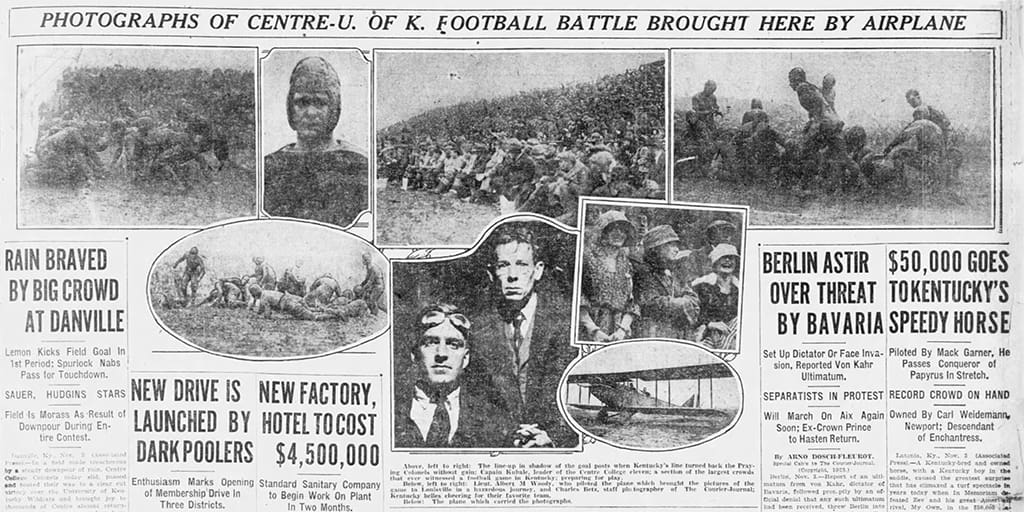
Front page coverage in the November 4, 1922, Louisville "Courier-Journal." The sellout crowd is seen at the upper center of layout at the dedication of the new stadium.
No one knew how dangerous the trip had been to allow the images to be published in such a timely manner.
No one, except for one brave young pilot and one intrepid photographer.
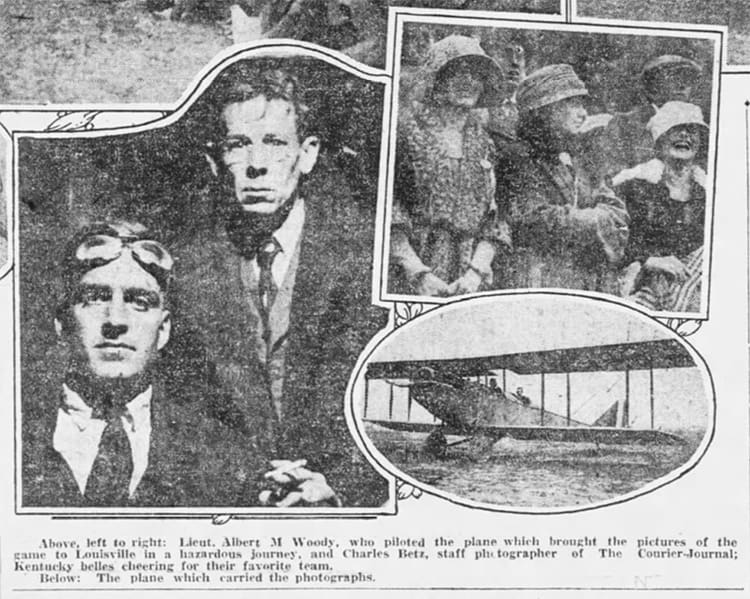
Lieutenant Albert Woody and photographer Charles Betz, left photo
Such was the importance of Centre and its football team during the era of the "Wonder Team."
